Comments / Questions (16)
![]() Ros Wilson wrote:
Ros Wilson wrote:
On the Left shoulder piece, I have picked up the stitches and worked the length of stocking stitch required for my size but at the end of the paragraph it says “noting which row in A1 you finished on” . As far as I can see from the photos, A1 does not start until after the neck has been joined.
18.04.2025 - 00:23DROPS Design answered:
Dear Ros, it seems to be a typo, omit this sentence from the instructions. We will correct it as soon as possible. So it should be: "Cut the strand, place the stitches on a stitch holder. Now work the right front piece." Happy knitting!
20.04.2025 - 22:56
![]() Helena Dimitriou wrote:
Helena Dimitriou wrote:
2 m slätstickning, börja vid pilen för vald storlek och sticka de 2 återstående m i A.1, sticka hela A.1 totalt 3 ggr, sedan stickas de första 3 m i A.1, avsluta med 2 maskor slätstickning Stl L = 105m A1 *3 = 93 m 105-93=12 Men får inte ihop hur jag ska sticka dom 12, bara 9 finns beskrivna ovan? Tacksam för hjälp. Mvh Helena
26.02.2025 - 12:38
![]() Julie wrote:
Julie wrote:
Quelle taille porte le mannequin svp ?
20.02.2025 - 11:46DROPS Design answered:
Bonjour Julie, la plupart du temps, nos modèles portent soit une taille S soit une taille M - pour trouver votre taille, mesurez un vêtement similaire que vous avez et dont vous aimez la forme et comparez ces mesures à celles du schéma - retrouvez plus d'infos ici. Bon tricot!
20.02.2025 - 14:43
![]() KS wrote:
KS wrote:
Well I'm puzzled. Most fair isle colour work patterns I have used are worked from the bottom up and are numbered first row starts on the right to left, second row (purl) starts left to right and so on. Without row numbers I'm baffled. I'm making a medium so there's only one stitch required as per instructions. But it messes up the pattern. What am I doing wrong?
23.01.2025 - 05:03
![]() Deborah Kosiw wrote:
Deborah Kosiw wrote:
Is there any video of increasing from front/back? I want to make sure I am doing it right
12.12.2024 - 03:59DROPS Design answered:
Dear Deborah, here is a video on how to increase in the front or back loop: https://www.garnstudio.com/video.php?id=9&lang=en. Happy knitting!
15.12.2024 - 15:42
![]() Marie wrote:
Marie wrote:
Thank you. That was a very quick response
14.10.2024 - 10:37
![]() Marie wrote:
Marie wrote:
Re snowflake pattern I am having a problem with back starting chart A1. I have done the part chart then 2 repeats of chart and final half chart on row 1 Row 2 just doesn’t seem to match up any way left to right or right to left. Could you please explain. Thank you
13.10.2024 - 19:34DROPS Design answered:
Dear Marie, you start with the first row right to left, then the following row will be right to left. Remember to work A.1 over A.1 and the stitches in stocking stitch in sage green on each side are worked also in stocking stitch in the same colour in the next row. You need to work exactly the same stitches of the chart over the stitches of the chart worked in the previous row, so the partial repeat starts in the same place as it ended before and is worked from left to right. Happy knitting!
14.10.2024 - 00:14
![]() Magpie wrote:
Magpie wrote:
Frosty window
12.08.2024 - 10:44
![]() Malene Siedentopp wrote:
Malene Siedentopp wrote:
Snowflack
11.08.2024 - 20:18
![]() Jaqueline wrote:
Jaqueline wrote:
Cosy Hugs
11.08.2024 - 15:52
Snowflake Sky#snowflakeskysweater |
||||||||||||||||
 |
 |
|||||||||||||||
Knitted over-sized jumper in DROPS Air. The piece is worked top down with European/diagonal shoulders, Nordic pattern and rolled neck-edge. Sizes XS-XXL.
DROPS 255-35 |
||||||||||||||||
|
------------------------------------------------------- EXPLANATIONS FOR THE PATTERN: ------------------------------------------------------- INCREASE TIP-1: INCREASE 1 STITCH TOWARDS THE LEFT – from the right side: Use the left needle to pick up the strand between 2 stitches from the previous row, pick up the strand from the front and knit the back loop. INCREASE 1 STITCH TOWARDS THE RIGHT – from the right side: Use the left needle to pick up the strand between 2 stitches from the previous row, pick up the strand from the back and knit the front loop. INCREASE TIP-2: INCREASE 1 STITCH TOWARDS LEFT – from wrong side: Use the left needle to pick up the strand between 2 stitches from the previous round, pick up the strand from the back and purl the front loop. INCREASE 1 STITCH TOWARDS RIGHT – from wrong side: Use the left needle to pick up the strand between 2 stitches from the previous round, pick up the strand from the front and purl the back loop. INCREASE TIP-3 (evenly spaced): To work out how to increase evenly, count the total number of stitches on the needle (e.g., 178 stitches) and divide by the number of increases to be made (e.g., 30) = 5.9. In this example, increase by making 1 yarn over after approx. each 6th stitch. On the next round work the yarn overs twisted to avoid holes. PATTERN: See diagrams A.1 to A.6. The diagrams show the pattern from the right side and the patterns are worked in stocking stitch. Choose diagram for your size (applies to A.5). Find the correct side in the diagram (applies to A.1 - A.3/A.4). KNITTING TIP-1: Mark on the diagram where the back piece finishes (on which row) – this makes it easier to match the armholes on the front piece. KNITTING TIP-2: When working short rows, there will be a small hole after each turn – this hole can be closed by tightening the strand or using the technique German Short Rows as follows: Slip the first stitch purl-wise, lay the strand over the right needle and tighten well from the back. There are now 2 loops on the needle, which are worked together on the next row. DECREASE TIP: Decrease 1 stitch on each side of the marker-thread as follows: Work until there are 3 stitches left before the marker-thread, knit 2 together with the background colour, knit 2 with the background colour (marker-thread sits between these 2 stitches), knit 2 together with the background colour (2 stitches decreased). ------------------------------------------------------- START THE PIECE HERE: ------------------------------------------------------- JUMPER – SHORT OVERVIEW OF THE PIECE. The pattern uses both long and short needles; start with the length which fits the number of stitches and change when necessary. The piece is started by casting on stitches at the back of the neck and working the back piece back and forth, top down, while increasing stitches on each side for the shoulders, which become slightly diagonal. The back piece is worked as far as the armholes. The front piece is started in 2 sections, knitting up stitches along one back shoulders and working downwards with pattern while increasing for the neckline, then repeating this on the other shoulder. The 2 sections are joined when the increases for the neckline are finished, and the front piece is continued back and forth until the armholes are finished. The front and back pieces are joined on the same circular needle and the body finished, in the round. Stitches are knitted up around the armholes for the sleeves, which are started back and forth for the sleeve cap, then finished in the round. Stitches are knitted up around the neckline and the neck worked in the round. BACK PIECE: The piece is worked back and forth. Cast on 31-33-33-33-37-37 stitches with circular needle size 5 mm and colour sage green DROPS Air. ROW 1 (wrong side): Purl. ROW 2 (right side): Read INCREASE TIP-1. Knit 2, increase 1 stitch towards the left, knit until there are 2 stitches left, increase 1 stitch towards the right, knit 2. ROW 3 (wrong side): Read INCREASE TIP-2. Purl 2, increase 1 stitch towards the left, purl until there are 2 stitches left, increase 1 stitch towards the right, purl 2. Work ROWS 2 and 3 a total of 14-15-17-18-19-21 times (28-30-34-36-38-42 worked rows) = 87-93-101-105-113-121 stitches. The piece measures approx. 13-14-16-16-17-19 cm from the cast-on edge mid-back. Insert 1 marker outermost on 1 side. The piece is now measured from here! On the next row from the right side, work PATTERN – read description above, as follows: Work 2 stocking stitches in colour sage green, start at the arrow for your size and work the last 9-12-32-2-6-10 stitches in A.1, then work A.1 a total of 2-2-2-3-3-3 times, the first 10-13-1-3-7-11 stitches in A.1 (so the pattern is symmetrical on both sides) and 2 stocking stitches in colour sage green. Continue this pattern back and forth. Remember to maintain the knitting tension. When A.1 is finished in height, work A.2 in the same way, i.e., 2 stocking stitches in colour sage green, start at the arrow for your size and work the last 9-12-32-2-6-10 stitches in A.2, then work A.2 a total of 2-2-2-3-3-3 times, the first 10-13-1-3-7-11 stitches in A.2 and 2 stocking stitches in colour sage green. A.2 is repeated in height. Work until the piece measures 14-15-15-16-17-17 cm measured along the armhole from the marker, finishing after a row from the wrong side – read KNITTING TIP-1. Cut the strand, place the stitches on a stitch holder. Work the left shoulder and front piece as follows: LEFT FRONT PIECE: Find the left shoulder on the back piece as follows: Lay the piece flat, right side up, with the stitch holder towards you; left side of piece = left shoulder. Starting from the right side, knit up stitches along the left back shoulder, from the neck to the armhole as follows: Use colour sage green and knit up 1 stitch in each worked row, inside 1 stitch along the shoulder, then 1 stitch in each of the next 2 rows outermost on the shoulder = 30-32-36-38-40-44 stitches. All measurements for the piece are taken from this knitted-up row. Work stocking stitch back and forth. When the piece measures 7-7-9-9-9-10 cm, increase for the neckline as follows: ROW 1 (right side): Remember INCREASE TIP-1. Knit 2, increase 1 stitch towards the left, knit to end of row. ROW 2 (wrong side): Purl. Work ROWS 1 and 2 a total of 4 times (8 worked rows) = 34-36-40-42-44-48 stitches. Cut the strand, place the stitches on a stitch holder, noting which row in A.1 you finished on. Now work the right front piece. RIGHT FRONT PIECE: Starting from the right side, knit up stitches along the right back shoulder from the armhole to the neck as follows: Use colour sage green, start 2 rows before the last increase for the shoulder and knit up inside 1 stitch, 1 stitch in each of these rows, then 1 stitch in each worked row along the shoulder to the neck = 30-32-36-38-40-44 stitches. All measurements for the piece are taken from this knitted-up row. Work stocking stitch back and forth. When the piece measures 7-7-9-9-9-10 cm, increase for the neckline as follows: ROW 1 (right side): Knit until there are 2 stitches left on the row, increase 1 stitch towards the right, knit 2 - remember INCREASE TIP-1. ROW 2 (wrong side): Purl. Work ROWS 1 and 2 a total of 4 times (8 worked rows) = 34-36-40-42-44-48 stitches. Now join the 2 front pieces together. FRONT PIECE: Work as follows from the right side: Work the 34-36-40-42-44-48 stitches from the right front piece, cast on 19-21-21-21-25-25 stitches for the neckline, work the 34-36-40-42-44-48 stitches from the left front piece = 87-93-101-105-113-121 stitches. Work stocking stitch back and forth. When the piece measures 12-12-14-14-14-16 cm from the knitted-up row (approx. 1-1-1-1-1-2 cm of stocking stitch after the cast-on stitches mid-front) and with the next row from the right side, work PATTERN as follows: Work 2 stocking stitches in colour sage green, start at the arrow for your size and work the last 9-12-32-2-6-10 stitches in A.1, then work A.1 a total of 2-2-2-3-3-3 times, the first 10-13-1-3-7-11 stitches in A.1 (so the pattern is symmetrical on both sides) and 2 stocking stitches in colour sage green. Continue this pattern back and forth. When A.1 is finished in height, work A.2 in the same way, i.e., 2 stocking stitches in colour sage green, start at the arrow for your size and work the last 9-12-32-2-6-10 stitches in A.2, then work A.2 a total of 2-2-2-3-3-3 times, the first 10-13-1-3-7-11 stitches in A.2 and 2 stocking stitches in colour sage green. Work until the piece measures 26-27-29-30-31-33 cm from the knitted-up row, finishing after a row from the wrong side (the same row as on the back piece). Now join the front and back pieces for the body. The piece is now measured from here! BODY: Continue the pattern across the 87-93-101-105-113-121 stitches on the front piece, cast on 2-2-2-8-8-8 stitches (in side mid-under sleeve), continue the pattern across the 87-93-101-105-113-121 stitches from the back piece, cast on 2-2-2-8-8-8 stitches (in side mid-under sleeve) = 178-190-206-226-242-258 stitches. Work pattern in the round, with A.2 on the front and back pieces and A.5 under each sleeve as follows: Work the first 2 stitches according to the last 2 stitches in A.5, continue A.2 across the next 83-89-97-101-109-117 stitches (= front piece), work A.5 across the next 6-6-6-12-12-12 stitches (2-2-2-8-8-8 cast-on stitches + 2 stitches on each side), continue A.2 across the next 83-89-97-101-109-117 stitches (= back piece), work the last 4-4-4-10-10-10 stitches according to the first 4-4-4-10-10-10 stitches in A.5. Work until the piece measures 26-27-26-27-27-27 cm from the armholes (the front piece measures approx. 52-54-55-57-58-60 cm from the knitted-up row) and finishing after a round marked either with star-1 or star-2 in A.2. If you finish after a round with star-1, work A.3 across the stitches in A.2 (starting at the correct arrow and continuing the pattern, with A.5 in each side as before). If you finish after a round with star-2, work A.4 across the stitches in A.2 (starting at the correct arrow and continuing the pattern, with A.5 in each side as before). When A.3/A.4 is finished in height, work 2 rounds of stocking stitch, using colour sage green. Change to circular needle size 3.5 mm and work rib with colour sage green (knit 1, purl 1). AT THE SAME TIME, increase 30-34-38-38-42-46 stitches evenly on round 1 – read INCREASE TIP-3 = 208-224-244-264-284-304 stitches. When the rib measures 5-5-6-6-7-7 cm, cast off a little loosely with rib. The front piece measures approx. 59-61-63-65-67-69 cm from the knitted-up row, and is approx. 3 cm longer than the finished length as the knitted-up row is not on top of the shoulder but positioned slightly down the back piece. The jumper measures approx. 56-58-60-62-64-66 cm. SLEEVES: The sleeves are worked top down. Lay the piece flat and insert 1 marker mid-top of shoulder (NOTE! Mid-top of shoulder is not the knitted-up row on the front piece but approx. 6 to 8 cm down the front piece). Use circular needle size 3.5 mm and colour sage green. Start in the middle of the cast-on stitches under the sleeve and knit up 65-67-73-83-85-91 stitches (inside 1 stitch) around the armhole, making sure you have equal numbers of stitches on each side of the marker on the shoulder. Change to circular needle size 5 mm. Insert 1 marker in the middle stitch on the row (= mid-stitch on top of sleeve, which should have a different colour from the first marker). Starting mid-under the sleeve, work stocking stitch and short rows back and forth for the sleeve cap (so the sleeve has a better fit) as follows: ROW 1 (right side): Knit to 8-8-8-9-9-9 stitches past the first inserted marker on the shoulder, turn – read KNITTING TIP-2. ROW 2 (wrong side): Purl to 8-8-8-9-9-9 stitches past the marker, turn. ROW 3 (right side): Knit to 7-7-7-7-7-7 stitches past the previous turn, turn. ROW 4 (wrong side): Purl to 7-7-7-7-7-7 stitches past the previous turn, turn. Repeat ROWS 3 and 4 onwards until you have turned a total of 8-8-8-8-10-10 times (4-4-4-4-5-5 times on each side, with the last row from the wrong side). AFTER THE LAST TURN: Knit back from the right side to the beginning of the round (mid-under sleeve). Insert 1 marker-thread at the beginning of the round; this is used when decreasing under the sleeve. Allow the thread to follow your work onwards. You now work stocking stitch in the round, decrease under the sleeve and work PATTERN – read description above. Read the next 2 sections before continuing. DECREASING: When the sleeve measures 1 cm from the join, decrease 1 stitch on each side of the marker-thread– read DECREASE TIP. Decrease like this every 2nd round a total of 2-2-2-8-8-8 times, then every 1½ cm 6-7-7-6-7-7 times = 49-49-55-55-55-61 stitches. PATTERN: Remember the decreases. When the sleeve measures 8-8-7-7-6-6 cm from the shoulder-marker, work A.6 round the sleeve – the pattern will not fit under the sleeve; count out from the marker-stitch on top of the sleeve to determine where to start the pattern under the sleeve; the marker-stitch should match the mid-stitch in A.6. Work A.6 a total of 5-5-5-5-4-4 times in height, work the first 3 rounds in A.6, then work stocking stitch with colour sage green to finished length. Work until the sleeve measures 42-42-40-39-37-36 cm from the marker on the shoulder. Change to double pointed needles size 3.5 mm, work rib (knit 1, purl 1) with colour sage green. AT THE SAME TIME, increase 7-7-9-9-9-11 stitches evenly on the first round = 56-56-64-64-64-72 stitches. When the rib measures 5-5-6-6-7-7 cm cast off a little loosely with rib. The sleeve measures approx. 47-47-46-45-44-43 cm from the marker on the shoulder. NECK: Use circular needle size 3.5 mm and colour sage green. Start from the right side on one shoulder-line and knit up 96-100-108-108-120-124 stitches inside 1 stitch (if you knit up fewer stitches than this, adjust to the correct number on round 1) – the stitch count should be divisible by 2, with 1 knitted stitch on each shoulder-line. Work rib in the round (knit 1, purl 1) for 5-5-5-6-6-6 cm. Work 3 rounds of stocking stitch (rolled edge). Change to circular needle size 5 mm, cast off a little loosely with knit. |
||||||||||||||||
Diagram explanations |
||||||||||||||||
|
||||||||||||||||
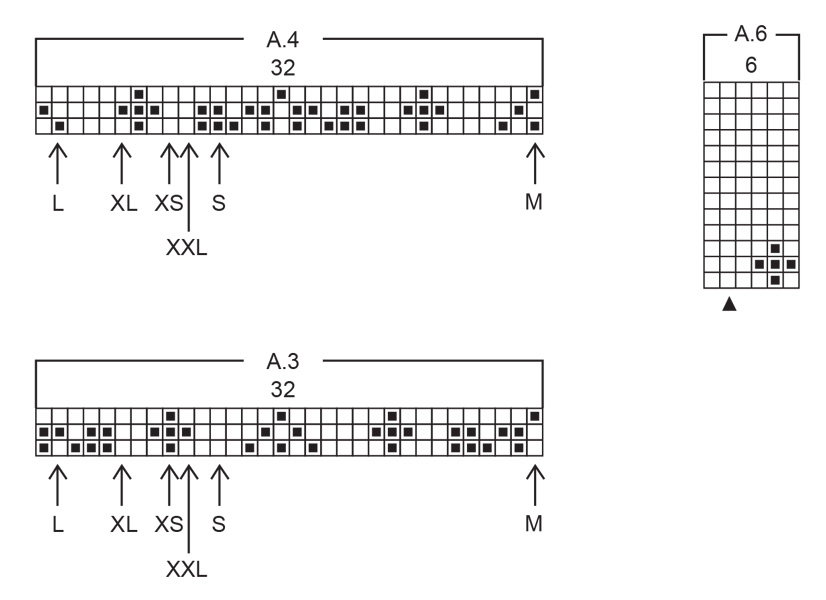
|
||||||||||||||||

|
||||||||||||||||
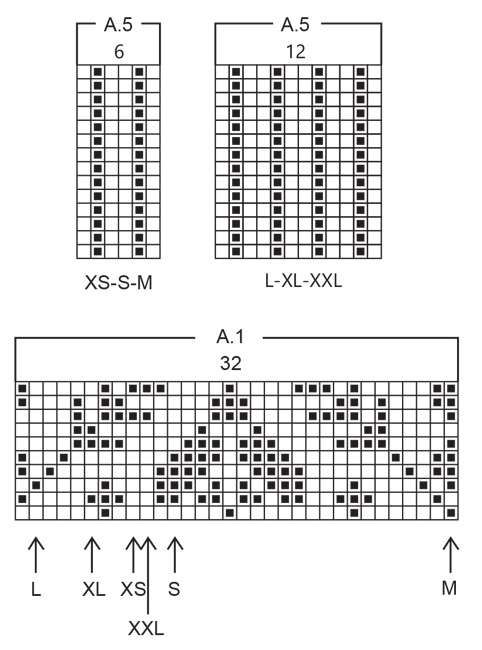
|
||||||||||||||||

|
||||||||||||||||
Have you finished this pattern?Tag your pictures with #dropspattern #snowflakeskysweater or submit them to the #dropsfan gallery. Do you need help with this pattern?You'll find 34 tutorial videos, a Comments/Questions area and more by visiting the pattern on garnstudio.com. © 1982-2025 DROPS Design A/S. We reserve all rights. This document, including all its sub-sections, has copyrights. Read more about what you can do with our patterns at the bottom of each pattern on our site. |
||||||||||||||||







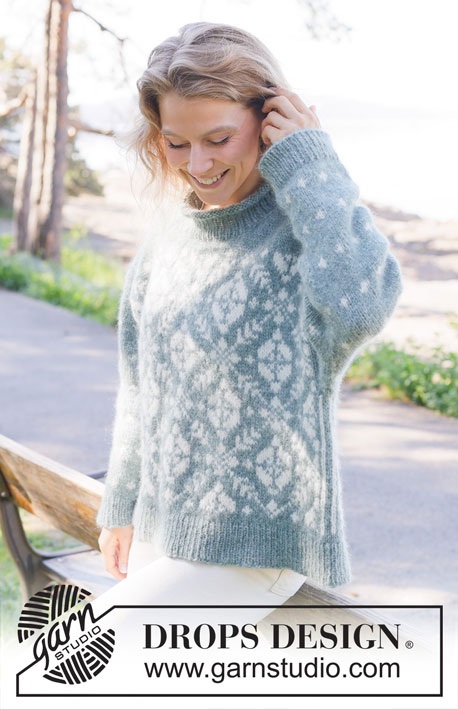

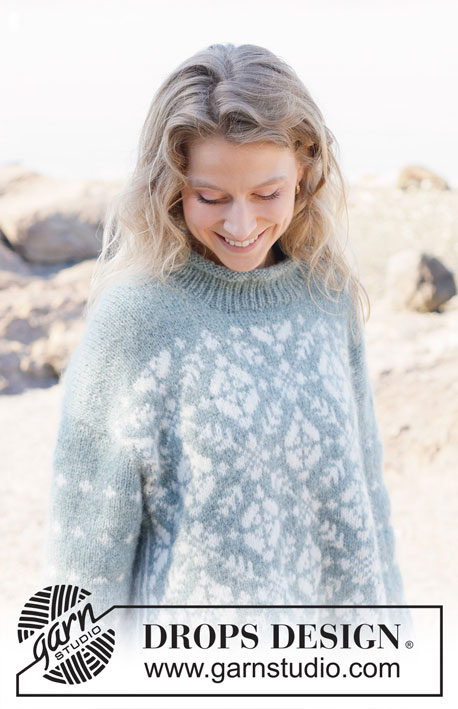
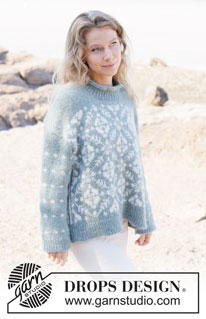





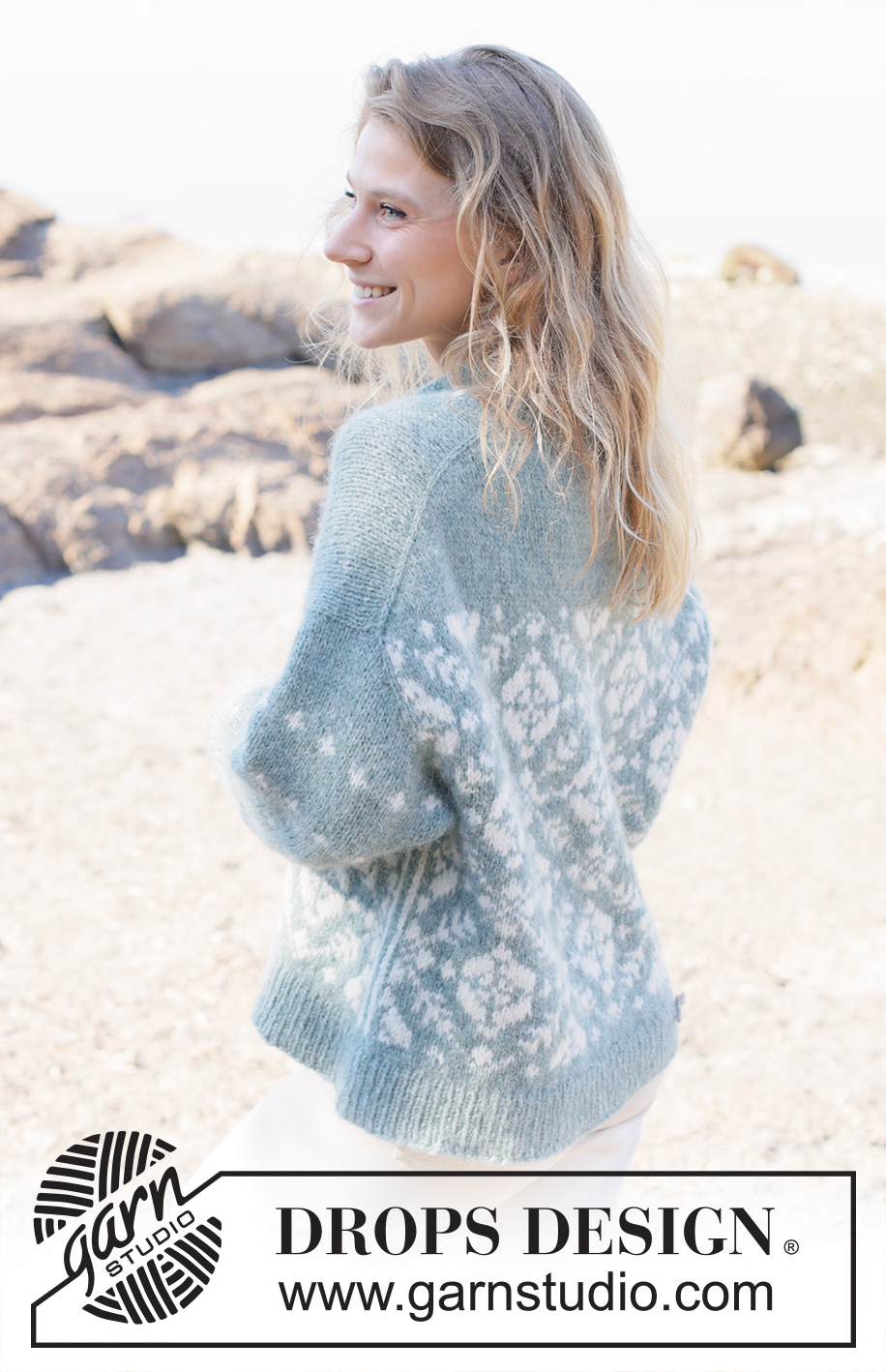







































































Post a comment to pattern DROPS 255-35
We would love to hear what you have to say about this pattern!
If you want to leave a question, please make sure you select the correct category in the form below, to speed up the answering process. Required fields are marked *.